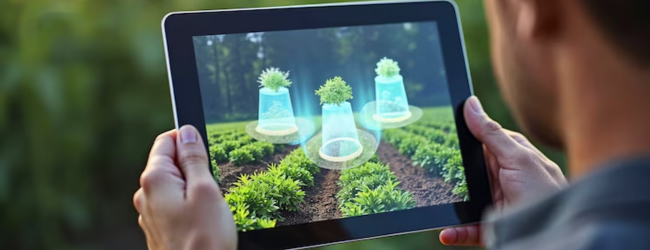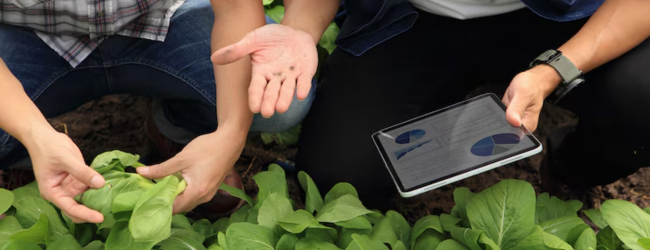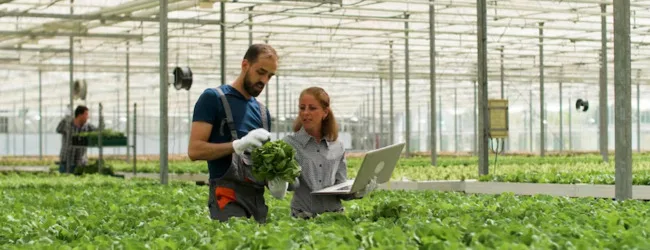Table of contents
- What is Smart Farming?
- Key Techniques for Smart Farming in India
- 1. Precision Agriculture: Tailoring Inputs for Optimal Output
- 2. Remote Sensing and GIS: Seeing the Bigger Picture
- 3. Internet of Things (IoT): Connecting the Farm
- 4. Artificial Intelligence (AI) and Machine Learning (ML): Intelligent Insights
- 5. Big Data Analytics: Unlocking Hidden Value
- 6. Farm Management Software: The Central Nervous System
- 7. Robotics and Automation: The Future of Farm Labour
- Investment in Smart Farming in India
- Benefits of Smart Farming in India
- Challenges in Adopting Smart Farming in India
- Conclusion
- Frequently Asked Questions (FAQs)
Smart farming in India is revolutionising agriculture, offering the potential to increase yields, optimise resource use, and improve the livelihoods of farmers. By leveraging advanced technologies, Indian agriculture is moving towards a more efficient and sustainable future. This article delves into the various techniques, investment aspects, and significant benefits of adopting smart farming practices in the Indian context.
What is Smart Farming?
At its core, smart farming involves using information and communication technologies (ICT) to manage and optimise agricultural processes. It moves beyond traditional methods by incorporating data-driven insights for informed decision-making. Think of it as precision agriculture, where every input – water, fertiliser, pesticides – is applied exactly where and when needed, minimising waste and maximising output.
Key Techniques for Smart Farming in India

The landscape of smart farming in India is being shaped by a confluence of cutting-edge technologies. These techniques are not merely futuristic concepts but are increasingly being adopted by farmers across the country, albeit at varying scales. Let’s delve deeper into each of these pivotal techniques:
1. Precision Agriculture: Tailoring Inputs for Optimal Output
Precision agriculture (PA) stands as the cornerstone of smart farming. It’s about moving away from uniform field management to site-specific management. This approach recognises that within a single field, there can be significant variations in soil properties, nutrient levels, moisture content, pest infestations, and microclimates. PA aims to address these variations by applying the right inputs – water, fertilisers, pesticides, seeds – at the right time, in the right place, and in the right amounts.
Components of Precision Agriculture:
- Global Positioning System (GPS): Enables precise location identification within the field, allowing for accurate mapping and targeted operations. Farmers using GPS-guided tractors can ensure parallel passes, reducing overlaps and optimising field coverage.
- Geographic Information Systems (GIS): Software systems used to capture, store, analyse, and manage spatial data. GIS helps create detailed maps of fields, layering information like soil types, yield data, and pest incidence.
- Sensors: A wide array of sensors are deployed to collect real-time data:
- Soil Sensors: Measure parameters like moisture content, temperature, pH, electrical conductivity, and nutrient levels (e.g., nitrogen, phosphorus, potassium – NPK). Companies like Terracon Ecotech are providing soil health monitoring solutions.
- Weather Stations: Monitor local weather conditions such as temperature, humidity, rainfall, wind speed, and solar radiation. This helps in scheduling irrigation, predicting disease outbreaks, and optimising planting times. Startups like Skymet provide localised weather forecasts for farmers.
- Plant Health Sensors: Assess crop vigour, chlorophyll content, and stress levels using spectral imaging or direct contact sensors. This helps in early detection of nutrient deficiencies or diseases.
- Yield Monitors: Fitted on combine harvesters, these sensors record the amount of grain harvested at different locations within the field, creating yield maps that inform future planting and fertilisation strategies.
Variable Rate Technology (VRT): Equipment capable of automatically adjusting the application rate of inputs based on real-time data or pre-defined prescription maps. For instance, a VRT-enabled fertiliser spreader can apply more fertiliser in nutrient-deficient zones and less in areas with sufficient nutrients.
Data Analytics: Sophisticated software and algorithms analyse the vast amounts of data collected by sensors and other sources to generate actionable insights for farmers. This includes creating prescription maps for VRT, predicting yields, and identifying areas requiring attention.
2. Remote Sensing and GIS: Seeing the Bigger Picture
Remote sensing technologies, primarily using satellite imagery and drone-based systems, provide a bird’s-eye view of agricultural landscapes. Coupled with GIS, this data becomes invaluable for large-scale monitoring and analysis.
Satellite Imagery: Satellites equipped with multispectral and hyperspectral sensors capture images of the Earth’s surface in different wavelengths of light. Analysing these spectral signatures can provide information about:
- Crop Health: Healthy vegetation reflects light differently than stressed or diseased plants. Indices like the Normalised Difference Vegetation Index (NDVI) are derived from satellite data to assess crop vigour. Agencies like the NRSC provide regular crop health assessments using satellite data.
- Area Estimation: Satellite imagery is used to accurately estimate the area under different crops at regional and national levels, aiding in policy planning and market forecasting.
- Disaster Assessment: Monitoring the impact of floods, droughts, and other natural disasters on agricultural areas.
- Soil Mapping: Identifying different soil types and their spatial distribution.
Drone Technology (Unmanned Aerial Vehicles – UAVs): Drones offer higher spatial and temporal resolution compared to satellites. They can be deployed on demand to capture detailed images and videos of individual fields.
- Crop Monitoring: High-resolution imagery can detect early signs of pest infestations, diseases, and nutrient deficiencies that might not be visible to the naked eye.
- Irrigation Management: Thermal cameras on drones can identify areas with water stress, helping optimise irrigation schedules.
- Yield Estimation: By analysing plant height and canopy cover, drones can provide early yield estimates.
- Precision Spraying: Drones equipped with sprayers can precisely apply pesticides or fertilisers only where needed, reducing chemical usage and environmental impact. Companies like Garuda Aerospace are developing agricultural drones for various applications in India.
3. Internet of Things (IoT): Connecting the Farm
The Internet of Things (IoT) involves a network of physical devices, vehicles, buildings, and other items embedded with sensors, software, and connectivity which enables these objects to collect and exchange data. In agriculture, IoT creates a connected ecosystem on the farm.
Key IoT Applications in Indian Agriculture:
- Smart Irrigation Systems: Soil moisture sensors, weather data, and automated valves work together to deliver the precise amount of water needed by crops, optimising water use and reducing labour.
- Smart Greenhouses: Sensors monitor and control environmental parameters like temperature, humidity, light, and CO2 levels to create optimal growing conditions for crops in protected cultivation.
- Livestock Monitoring: Wearable sensors on livestock can track their health, location, and behaviour, enabling early detection of diseases and improved management.
- Automated Farm Equipment: IoT enables remote monitoring and control of farm machinery, such as tractors and harvesters, improving efficiency and reducing downtime.
- Supply Chain Monitoring: Sensors attached to agricultural produce during transportation can monitor temperature, humidity, and location, ensuring quality and reducing spoilage.
💡 Pro Tip: If you want to start a farming business but have too many doubts, connect with a farming business expert from Boss Wallah for guidance – Check Out
4. Artificial Intelligence (AI) and Machine Learning (ML): Intelligent Insights
AI and ML algorithms analyse the vast datasets generated from various smart farming technologies to identify patterns, make predictions, and automate decision-making.
Applications of AI/ML in Indian Agriculture:
- Yield Prediction: Analysing historical weather data, soil information, and crop growth parameters to forecast yields with greater accuracy, aiding in market planning and storage management.
- Disease and Pest Detection: AI-powered image recognition can analyse images from drones or smartphones to identify plant diseases and pests at early stages, allowing for timely and targeted interventions. Startups like AgNext are using AI for quality assessment and pest detection.
- Weed Detection and Control: AI algorithms can differentiate between crops and weeds in images, enabling precise robotic weeding or targeted herbicide application.
- Irrigation Optimisation: ML models can learn from historical data and real-time sensor readings to optimise irrigation schedules and water usage.
- Market Price Forecasting: Analysing market trends and historical data to predict future prices of agricultural commodities, helping farmers make informed selling decisions.
- Personalised Advisory Services: AI-powered platforms can provide farmers with customised recommendations on crop selection, input management, and pest control based on their specific farm conditions.
5. Big Data Analytics: Unlocking Hidden Value
Smart farming generates massive amounts of data from various sources. Big data analytics involves processing and interpreting these large and complex datasets to extract meaningful insights.
Leveraging Big Data in Indian Agriculture:
- Identifying Trends and Patterns: Analysing data across multiple farms and seasons can reveal trends in pest outbreaks, disease patterns, and the effectiveness of different farming practices.
- Optimising Supply Chains: Analysing data on production, storage, and transportation can help optimise supply chains, reduce wastage, and improve market access for farmers.
- Policy Formulation: Aggregated agricultural data can provide valuable insights for policymakers to design effective agricultural programs and interventions.
- Risk Management: Analysing historical data on weather patterns and crop performance can help farmers and insurance companies assess and manage agricultural risks.
6. Farm Management Software: The Central Nervous System
Farm management software platforms integrate data from various smart farming technologies into a centralised system. This provides farmers with a holistic view of their operations and tools for planning, monitoring, and controlling different aspects of their farm.
Features of Farm Management Software:
- Record Keeping: Tracking planting dates, input applications, yields, expenses, and labour.
- Task Management: Scheduling and assigning tasks to farmworkers.
- Inventory Management: Tracking the stock of seeds, fertilisers, pesticides, and other inputs.
- Financial Management: Monitoring income and expenses, generating financial reports.
- Mapping and Analysis: Visualising field data, generating reports on yields, soil conditions, and other parameters.
- Communication and Collaboration: Facilitating communication between farmers, advisors, and other stakeholders. Several Indian agri-tech startups offer comprehensive farm management software solutions.
7. Robotics and Automation: The Future of Farm Labour
Robotics and automation are gradually making their way into Indian agriculture, offering the potential to improve efficiency, reduce labour costs, and perform tasks with greater precision.
Emerging Robotic Applications in India:
- Automated Irrigation: Robots can deploy and manage irrigation systems based on real-time soil moisture data.
- Robotic Weeding: Autonomous robots equipped with cameras and AI can identify and remove weeds without the use of herbicides.
- Automated Harvesting: Robots are being developed for harvesting fruits and vegetables, reducing reliance on manual labour, especially during peak seasons.
- Precision Planting: Robotic planters can sow seeds at precise depths and spacing, optimising plant population and resource use.
- Livestock Management Robots: Robots can assist with tasks like feeding, milking, and monitoring livestock.
The adoption of these key techniques in smart farming in India is a gradual process, influenced by factors like farm size, economic capacity of farmers, access to infrastructure, and awareness levels. However, the potential of these technologies to transform Indian agriculture towards greater efficiency, sustainability, and profitability is undeniable. As technology continues to evolve and become more accessible, we can expect to see wider adoption and further innovation in the realm of smart farming in India.
Investment in Smart Farming in India

The adoption of smart farming in India requires strategic investments from various stakeholders:
Government Initiatives: The Indian government is actively promoting smart agriculture through various schemes and policies, including:
- The National Mission on Agricultural Extension and Technology (NMAET): Supports the adoption of modern technologies in agriculture.
- The Pradhan Mantri Krishi Sinchayee Yojana (PMKSY): Focuses on efficient irrigation technologies.
- The Rashtriya Krishi Vikas Yojana (RKVY): Provides financial assistance for agricultural development projects, including those related to technology adoption.
- The Digital Agriculture Mission: Aims to leverage digital technologies to improve efficiency and transparency in the agriculture sector.
Private Sector Participation: Agri-tech startups and established companies are playing a crucial role in developing and deploying smart farming solutions. Venture capital funding in the Indian agri-tech sector has seen a significant rise, indicating growing investor confidence.
- Example: Companies like Cropin, AgNext, and Fasal are providing innovative solutions in areas like precision agriculture, quality assessment, and farm management.
Farmer Investment: While the initial investment in smart farming technologies can be a barrier for smallholder farmers, the long-term benefits often outweigh the costs. Farmer Producer Organisations (FPOs) can play a crucial role in aggregating demand and facilitating access to these technologies.
Research and Development: Continued investment in agricultural research is essential for developing context-specific smart farming solutions for India’s diverse agro-climatic zones. The Indian Council of Agricultural Research (ICAR) and State Agricultural Universities (SAUs) are actively involved in this area.
Benefits of Smart Farming in India
Adopting smart farming in India offers a multitude of benefits:
- Increased Productivity and Yields: Precision application of inputs and optimised resource management lead to higher crop yields.
- Highlight: Studies have shown that precision agriculture techniques can increase yields by 10-30% in some crops.
- Efficient Resource Management: Smart farming helps conserve water, fertilisers, and pesticides, reducing environmental impact and input costs.
- Example: Drip irrigation systems, controlled by soil moisture sensors, can reduce water usage by 40-60% compared to traditional flood irrigation.
- Improved Crop Quality: Precise nutrient management and timely interventions lead to better quality produce.
- Reduced Labour Costs: Automation and robotics can help reduce the reliance on manual labour, which is becoming increasingly scarce and expensive.
- Better Decision-Making: Real-time data and analytics empower farmers to make informed decisions regarding planting, irrigation, pest control, and harvesting.
- Enhanced Profitability: Higher yields, reduced input costs, and improved quality translate to increased income for farmers.
- Sustainable Agriculture: By minimising waste and optimising resource use, smart farming contributes to more sustainable agricultural practices.
- Improved Supply Chain Efficiency: Technology can help track produce from farm to market, reducing wastage and improving transparency.
- Risk Mitigation: Weather forecasting and disease prediction tools help farmers take proactive measures to mitigate risks.
ALSO READ | What is Integrated Farming System (IFS)? A Complete Guide
Challenges in Adopting Smart Farming in India

Despite the immense potential, there are challenges to the widespread adoption of smart farming in India:
- High Initial Investment Costs: The cost of sensors, drones, and other technologies can be prohibitive for smallholder farmers.
- Lack of Awareness and Digital Literacy: Many farmers in India lack the awareness and skills to effectively use smart farming technologies.
- Limited Access to Infrastructure: Poor internet connectivity and lack of reliable power supply in rural areas can hinder the deployment of digital farming solutions.
- Small Landholdings: The fragmented nature of landholdings in India can make it challenging to implement large-scale smart farming technologies.
- Data Privacy and Security Concerns: Farmers may be hesitant to share their data due to privacy and security concerns.
- Lack of Standardisation and Interoperability: The lack of standardisation in data formats and communication protocols can hinder the integration of different smart farming systems.
ALSO READ | Top 10 Old Farming Tools in India Still Used by Farmers Today
Need Expert Guidance?
Starting a business can be challenging, but you don’t have to do it alone! At Boss Wallah, our 2,000+ business experts are ready to provide valuable insights and guidance. Whether you need help with marketing, finance, sourcing, or any other area of any business, our business experts are here to help you succeed – Check Out
Confused about Which Business to Start?
Want to start your own business but unsure which one to choose? Explore Boss Wallah, where you’ll find 500+ courses by successful business owners, featuring practical, step-by-step guides on starting and growing various businesses.
Find your perfect business idea today – Check Out
Conclusion
Smart farming in India holds immense promise for transforming the agricultural sector. By embracing innovative technologies and fostering collaboration between government, private sector, and farmers, India can achieve greater agricultural efficiency, sustainability, and prosperity. While challenges remain, the increasing focus on digital agriculture and the growing number of successful pilot projects indicate a positive trajectory for the widespread adoption of smart farming practices across the country.
Frequently Asked Questions (FAQs)
- What is smart farming?
Smart farming uses technology like sensors, data analytics, and automation to improve agricultural practices. - What are the main technologies used in smart farming?
Key technologies include precision agriculture, IoT, AI, drones, and farm management software. - Is smart farming expensive?
Initial investment can be high, but long-term benefits often outweigh the costs. - How can smart farming help Indian farmers?
It can increase yields, reduce costs, improve resource management, and enhance profitability. - What are some government initiatives for smart farming in India?
Schemes like NMAET, PMKSY, and the Digital Agriculture Mission promote technology adoption. - Are there any successful examples of smart farming in India?
Yes, many farmers and FPOs are using precision irrigation, drone-based monitoring, and AI-powered disease detection with positive results. - What are the challenges in adopting smart farming in India?
High costs, lack of awareness, poor infrastructure, and small landholdings are some challenges. - How can smallholder farmers adopt smart farming?
FPOs can help aggregate demand and provide access to shared resources and knowledge. - What is the role of data in smart farming? Data from sensors, satellites, and other sources is analysed to make informed decisions.
- Is smart farming sustainable? Yes, by optimizing resource use and minimizing waste, it promotes sustainable agricultural practices.


